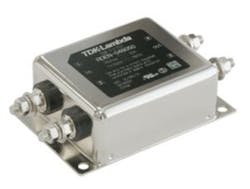Test and component makers address ESD, EMI concerns
Electronic products generally can’t ship without meeting EMC, EMI, or ESD requirements. New instruments, power supplies, and filters can help ensure that your ICs meet electrostatic discharge requirements and that you can power-up your test and other equipment without causing electromagnetic interference problems.
Langer EMV-Technik is addressing IC ESD requirements with the introduction of its 331-2 probe—an ESD generator that supports testing in accordance with the IEC/EN 61000-4-2 standard. It generates pulses from ±0.1 kV to 9 kV at pulse frequencies from 0.1 Hz to 10 Hz and can be used to test an IC’s ESD protection circuits.
The company says the probe’s mini ESD generator design allows direct contact to IC pins (Figure 1), adding that compared with conventional commercial ESD generators, it provides no extra unintended radiated electric and magnetic fields that could interfere with an IC under test and cause it to malfunction even though in compliance with the relevant IEC standard.
Courtesy of Langer EMV-Technik
The probe is suitable for measurements on all types of IC pins—particularly ones associated with USB, LVDS, and Ethernet interfaces. The probe can couple to an IC pin directly or via a single-pole coupling network. The probe works with the company’s BPS 203 Burst Power Station supply and TS 1002 IC test accessories set.
Gunter Langer, managing director of the company, wrote in an undated white paper, “The effort needed to make electronic devices immune to ESD according to EN 61000-4 has been steadily increasing over the past years.”1 He added, “The reduction in the structural width of ICs is one of the reasons for an increase in their susceptibility to disturbances.” He wrote that at the time when IC process geometries were moving from 100 nm down to 45 nm. The challenges only increase as we move to 20 nm and below.
Powering-up test equipment
Also concerned with electromagnetic disturbances and test is SL Power Electronics. At the 2014 International Test Conference, the company demonstrated its TU425 Series 425-W, single-output AC/DC internal power supplies. These supplies, the company said, address the unique needs of various types of test equipment, including oscilloscopes, analyzers, test boards, and chromatography mass detectors as well as industrial process-control systems that require clean, reliable power. The company added that the supplies offer up to 90% efficiencies and meet EMC requirements per EN 61000-4.
Moving beyond test and measurement, SL Power also is addressing EMC and EMI issues in architectural LED lighting applications with the introduction of the LB115 power supply family. The new power supply series delivers 115 W in a 2 x 4 x 1.2-inch footprint and has a built-in EMI filter to meet EN 55015 class B requirements for lighting fixtures. “The new LB115 family meets global EMI and EMC lighting requirements, giving design engineers an easy-to-integrate power supply on a standard platform that reduces time to market and eliminates a costly EMI filter,” said Maggie Nadjmi, product manager for SL Power Electronics.
Courtesy of TDK-Lambda
Also addressing EMC, TDK-Lambda recently announced the introduction of the metal-cased DC-input RDEN-048050 EMC filter (Figure 2) to complement its existing R Series AC input EMC filters. The RDEN-048050 can accept an input voltage of up to 76 VDC and is rated for currents up to 50 A.
Connections are made via rugged M5 studs for easy termination. The filter will operate at 50 A in an ambient of -30°C to 55°C, with derating to 20 A at 85°C. With frequencies between 0.2 MHz and 10 MHz, common-mode attenuation is 30 dB, and with frequencies between 0.7 MHz and 30 MHz, differential-mode attenuation is 25 dB.
Input-to-case (ground) isolation is 1,500 VDC, and isolation resistance is 500 MΩ at 500 VDC. The filter is certified to UL 60950-1 and EN 60939. The package size, excluding terminals, is 90 mm deep, 60 mm wide, and 30 mm high. The filter finds use in measurement equipment as well as commercial-off-the-shelf and general industrial equipment.
Reference
For more information


